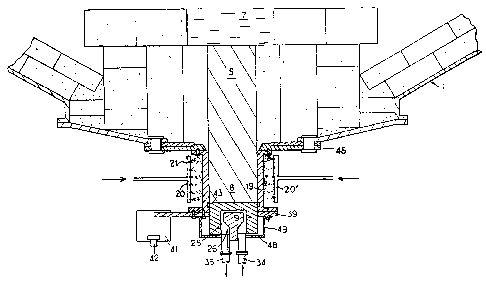Some of the information on this Web page has been provided by external sources. The Government of Canada is not responsible for the accuracy, reliability or currency of the information supplied by external sources. Users wishing to rely upon this information should consult directly with the source of the information. Content provided by external sources is not subject to official languages, privacy and accessibility requirements.
Any discrepancies in the text and image of the Claims and Abstract are due to differing posting times. Text of the Claims and Abstract are posted:
| (12) Patent: | (11) CA 2027300 |
|---|---|
| (54) English Title: | ELECTRIC CONNECTION DEVICE INTENDED TO BE PLACED IN THE WALL OF A METALLURGICAL CONTAINER IN CONTACT WITH MOLTEN METAL |
| (54) French Title: | CONNEXION ELECTRIQUE POUR PAROI DE RECIPIENT A METAL EN FUSION |
| Status: | Expired and beyond the Period of Reversal |
| (51) International Patent Classification (IPC): |
|
|---|---|
| (72) Inventors : |
|
| (73) Owners : |
|
| (71) Applicants : |
|
| (74) Agent: | ROBIC AGENCE PI S.E.C./ROBIC IP AGENCY LP |
| (74) Associate agent: | |
| (45) Issued: | 2001-07-24 |
| (22) Filed Date: | 1990-10-10 |
| (41) Open to Public Inspection: | 1991-04-12 |
| Examination requested: | 1997-06-18 |
| Availability of licence: | N/A |
| Dedicated to the Public: | N/A |
| (25) Language of filing: | English |
| Patent Cooperation Treaty (PCT): | No |
|---|
| (30) Application Priority Data: | ||||||
|---|---|---|---|---|---|---|
|
The electric connection device comprises an electrode
(5), a sleeve (19) mounted around a projecting end part (8)
of the electrode (5), and an arrangement for cooling the
sleeve (19) with a cooling fluid comprising at least one
system (20, 20') of nozzles (21) spraying cooling fluid onto
the outer surface of the sleeve (19).
Note: Claims are shown in the official language in which they were submitted.
Note: Descriptions are shown in the official language in which they were submitted.

2024-08-01:As part of the Next Generation Patents (NGP) transition, the Canadian Patents Database (CPD) now contains a more detailed Event History, which replicates the Event Log of our new back-office solution.
Please note that "Inactive:" events refers to events no longer in use in our new back-office solution.
For a clearer understanding of the status of the application/patent presented on this page, the site Disclaimer , as well as the definitions for Patent , Event History , Maintenance Fee and Payment History should be consulted.
| Description | Date |
|---|---|
| Inactive: IPC from MCD | 2006-03-11 |
| Time Limit for Reversal Expired | 2005-10-11 |
| Letter Sent | 2004-10-12 |
| Grant by Issuance | 2001-07-24 |
| Inactive: Cover page published | 2001-07-23 |
| Inactive: Final fee received | 2001-04-10 |
| Pre-grant | 2001-04-10 |
| Notice of Allowance is Issued | 2001-01-02 |
| Letter Sent | 2001-01-02 |
| Notice of Allowance is Issued | 2001-01-02 |
| Inactive: Approved for allowance (AFA) | 2000-12-13 |
| Inactive: IPC assigned | 2000-05-08 |
| Inactive: IPC removed | 2000-05-08 |
| Inactive: IPC assigned | 2000-05-08 |
| Inactive: First IPC assigned | 2000-05-08 |
| Letter Sent | 1997-08-01 |
| Amendment Received - Voluntary Amendment | 1997-07-31 |
| Inactive: Status info is complete as of Log entry date | 1997-07-29 |
| Inactive: Application prosecuted on TS as of Log entry date | 1997-07-29 |
| All Requirements for Examination Determined Compliant | 1997-06-18 |
| Request for Examination Requirements Determined Compliant | 1997-06-18 |
| Application Published (Open to Public Inspection) | 1991-04-12 |
There is no abandonment history.
The last payment was received on 2000-09-21
Note : If the full payment has not been received on or before the date indicated, a further fee may be required which may be one of the following
Patent fees are adjusted on the 1st of January every year. The amounts above are the current amounts if received by December 31 of the current year.
Please refer to the CIPO
Patent Fees
web page to see all current fee amounts.
| Fee Type | Anniversary Year | Due Date | Paid Date |
|---|---|---|---|
| Request for examination - standard | 1997-06-18 | ||
| MF (application, 7th anniv.) - standard | 07 | 1997-10-10 | 1997-09-15 |
| MF (application, 8th anniv.) - standard | 08 | 1998-10-13 | 1998-09-16 |
| MF (application, 9th anniv.) - standard | 09 | 1999-10-11 | 1999-09-16 |
| MF (application, 10th anniv.) - standard | 10 | 2000-10-10 | 2000-09-21 |
| Final fee - standard | 2001-04-10 | ||
| MF (patent, 11th anniv.) - standard | 2001-10-10 | 2001-09-19 | |
| MF (patent, 12th anniv.) - standard | 2002-10-10 | 2002-09-16 | |
| MF (patent, 13th anniv.) - standard | 2003-10-10 | 2003-09-15 |
Note: Records showing the ownership history in alphabetical order.
| Current Owners on Record |
|---|
| INSTITUT DE RECHERCHES DE LA SIDERURGIE FRANCAISE |
| Past Owners on Record |
|---|
| CHRISTIAN LEBRUN |
| GHISLAIN MAURER |
| JEAN-CLAUDE GROSJEAN |
| MICHEL HAMY |